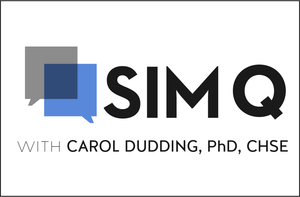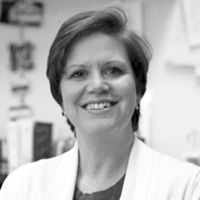From the Desk of Carol C. Dudding, PhD, CCC-SLP, CHSE

This is the second offering in our series of new monthly articles on simulations in healthcare, specifically in Allied Health Professions. The SimQ format, allows us to explore the technological as well as pedagogical aspects of simulation for clinical education through the words of the experts. It is anticipated that the audience will include university faculty, clinical educators, and professionals with interest in the use of simulations to enhance the clinical education of our students and practicing professionals. These articles are intended to address the needs of those considering the use of simulations, and those with varying experiences and level of skill.
This SimQ article provides information about getting started with simulations in your Allied Health Programs. It provides information about how to identify potential partnerships for simulation within your university and in the community, how to identify and reduce barriers that may be standing in your way, how to best utilize resources you already have available toward implementation of simulations, and how to develop a plan for participation in collaborative simulation experiences.
Julie M. Estis, Ph.D., CCC-SLP is Director of the TeamUSA Quality Enhancement Plan—a campus-wide initiative focused on using Team-Based Learning (TBL) at the University of South Alabama (USA) to improve student learning, critical thinking, communication, and collaboration. Appointed to the Department of Speech Pathology and Audiology faculty in 2004, simulation and interprofessional Education (IPE) are two of Dr. Estis's areas of passion and scholarly work. She collaborated with colleagues to create simulation-based IPE experiences for nursing, respiratory therapy, audiology, and medical students and developed a team-based IPE course for speech-language pathology and audiology graduate students. She is focused on creating meaningful learning experiences for students that foster teamwork and yield increased knowledge and skills.
Contributing Editor
SIMQ: Connecting and Collaborating: Building Your Simulation Team

Learning Outcomes
After this course, readers will be able to:
- Identify potential partnerships that reduce barriers to using simulation in their program.
- Develop a strategy for identifying existing simulation resources on their campuses and in their communities.
- Describe steps for a developing a collaborative simulation learning experience.
I have continuously sought to engage students in meaningful learning experiences through simulation, interprofessional education, and team-based learning since beginning my career as a speech-language pathology faculty member in 2004 at the University of South Alabama (South). I am currently Director of the TeamUSA Quality Enhancement Plan at South—a campus-wide initiative focused on implementing team-based learning (TBL) to improve student learning, critical thinking, communication, and collaboration. I enjoy working with colleagues from other disciplines to create engaging interprofessional simulation experiences for students and conducting research on the effectiveness of these approaches to learning.
1. How and when did you get started with simulations?
I first learned about simulation in 2007 when our Health Sciences Division (Colleges of Medicine, Nursing, and Allied Health) brought in a consultant to share the benefits of simulation in health science education and support us in developing a health sciences simulation program. I served as the speech-language pathology representative in those interactions and began the process of brainstorming use for simulation in speech-language pathology and audiology. From the early conversations around simulation at South, we took a collaborative, interprofessional approach rather than developing simulation in each college separately. Most importantly, I connected with collaborative faculty from other disciplines, and we became champions for moving simulation forward effectively by creating simulation learning experiences for our students.
2. So you have been involved in simulations for quite a long time. What types of simulation experiences/technologies have you been involved with?
I have been involved in simulation experiences utilizing task trainer manikins, high-fidelity robotic manikin simulators (adult and infant), and standardized patients. Here are a few examples:
Critical Care and Patient Monitoring: A high-fidelity robotic simulator was used to orient graduate speech-language pathology students to the critical care environment and to patient monitoring. The patient suffered a traumatic brain injury. Students identified common treatment and monitoring (e.g., chest tube, drain, catheter, IV, NG tube, oxygen, pulse oximetry) and interpreted physiologic monitoring of heart rate, oxygen saturation, and blood pressure.
Tracheostomy Care and Suctioning Lab: Task-trainers were used to train clinical skills for sterile gloving, tracheostomy care, and suctioning. Simulation faculty and nursing faculty collaborated to provide training, check-lists, and hands-on experience that matched the training received by nursing students.
Interprofessional Passy-Muir Valve Simulation: Working with colleagues from simulation, respiratory therapy, and nursing, we developed a scenario-based interprofessional simulation experience with the following learning objectives:
Understand the roles of RTs (respiratory therapists), SLPs (speech-language pathologists), and RNs (registered nurses) in caring for tracheostomy patients
- Explain the clinical indications and benefits of speaking valves for trach patients.
- Demonstrate appropriate clinical skills using high fidelity patient simulation.
- Evaluate and appreciate interdisciplinary collaboration and teamwork in patient care
After pre-briefing, interprofessional teams of students received orders to provide tracheostomy care and evaluation for/placement of Passy Muir Valve for a 65-year-old male. The patient was a robotic manikin simulator, and a standardized patient portrayed his family member. Students worked together to assess, treat, and educate the patient. A team-based debriefing, post-testing, and evaluation completed the simulation learning experience (Estis, J. M., Rudd, A. B., Pruitt, B., & Wright, T., 2015; Rudd, A., Estis, J.M., Pruitt, W., & Wright, T. 2016).
Safe Medication Administration in Patients with Communication Disorders: Colleagues in pharmacology (Elizabeth VandeWaa, Ph.D.), nursing (Alison B. Rudd, EdD, MSN, RN), audiology (Susan Gordon-Hickey, Au.D., Ph.D.) and I developed an interprofessional simulation learning experience. The aim was to help nursing, speech-language pathology, and audiology students understand each discipline's roles in helping patients with communication disorders manage and understand medications, identify high-risk medications with implications for patients receiving therapeutic services from the SLP or audiologist, demonstrate appropriate patient education related to medication management in patients with communication disorders, and evaluate interdisciplinary collaboration and teamwork in patient care. After pre-testing, online training, and pre-briefing, interprofessional teams of students interacted with standardized patients to identify high risk medications and provide appropriate patient education. De-briefing, self-reflections, evaluation, and post-testing were completed. (VandeWaa, E.A., Gordon-Hickey, S., Estis, J. M., & Rudd, A. 2015).
Evaluation of Preterm Infant Feeding Safety: With colleagues Neina Ferguson, Ph.D., CCC-SLP and Courtney Broadfoot, M.S., CCC-SLP, two simulation learning experiences were used to prepare students and to explore the effectiveness of a video-recorded simulation approach to evaluation of preterm infant feeding safety. Speech-language pathology, nursing, and non-health care students participated in online training which included video-recorded segments of a robotic manikin simulator (Baby Hal) during bottle feeding and analyzed behavioral and physiological indicators of readiness for oral feeding and of distress. This approach combines robotic manikin simulation with online learning to achieve student learning outcomes effectively and efficiently. This approach is a successful method for training caregivers to screen for infant dysphagia using an Oral Feeding Skills assessment tool and to identify signs of concern. (Ferguson, N. F., & Estis, J. M. 2018; Broadfoot, C. K., & Estis, J. M., 2018).
3. That’s an impressive list of simulation experiences. It certainly gives our readers an idea of the range and types of simulated learning experiences that are possible. What other professionals and staff are involved in these simulations?
For each of these experiences, a team approach is key. The team members vary based on the simulation experience but typically include faculty from each discipline involved, simulation faculty, simulation staff (logistics/supplies), simulation techs (control computers/manikins), and standardized patients. These partnerships have provided access to resources, valuable training and knowledge, and support throughout the process of developing and implementing simulation.
4. You have an impressive amount of resources at your university. What other types of simulations are being used on other campuses, that you are aware of?
In addition to the types of simulation I’ve mentioned, computer-based simulations are beneficial for interactive practice with various types of clinical cases. Immersive virtual reality is also used to create an immersive, 3D experience that simulates realistic contexts for role play and interprofessional education. Computer-based simulations and virtual reality can provide a variety of experiences for students across the age range, and with specific disorder areas. These can include prevention activities, assessments, intervention sessions, or a part-task trainer targeting one particular skill or skill set. This is one reason why programs are adopting the use of simulations; they can ensure specific experiences leading to specific competencies.
5. We often hear that it isn’t easy for allied health students to get access to simulation labs, especially those funded and run by other colleges/programs. What were the barriers that you first experienced?
For me, scheduling and timing were significant barriers for interprofessional education, given the demanding clinical and didactic requirements of each program involved. The faculty and ideas were in place, but it was a challenge to determine common dates and times. I commonly hear from faculty trying to begin using simulation that access to simulation facilities and staff is a limitation on many campuses. I recommend building relationships with those from other disciplines who use simulation and looking for opportunities to help them achieve their goals by involving you and your students. For example, many programs need to increase interprofessional education opportunities for their students, and you may be able to get started by helping them create a simulation experience that involves multiple disciplines.
6. Those are helpful suggestions. Which barriers persist for you even now?
Scheduling common times across programs and disciplines continues to require advanced planning. With dedicated faculty champions from each discipline, we were able to reduce this barrier by planning months or even a year in advance when creating interprofessional simulation experiences. In general, funding and access to simulation resources, technology, and equipment are commonly cited concerns of faculty who want to implement simulation. Faculty also report lack of training in the design and implementation of simulations as barriers to getting started. To overcome these obstacles, consider starting small with lower cost experiences and building simulation over time as you gain buy-in and support from colleagues and administrators.
7. How have the simulation experiences benefited your students?
Simulation allows students to develop knowledge and clinical skills in a low-risk, structured environment, preparing them for clinical practice. Data from experiences I’ve been involved with shows increased knowledge and skill and high rates of student satisfaction with the experiences. Also, interprofessional simulation experiences provide a meaningful context for developing interprofessional competencies (e.g., values/ethics, roles/responsibilities, interprofessional communication, teams and teamwork). Experiences are customized so that you can ensure each student participates in a particular scenario with specific disorder areas, which you cannot control for in the real world. Students are then better prepared to enter off-campus practica with confidence.
8. Not many SLPs are experienced in the best-practices for teaching with healthcare simulations. How did you learn about pre-briefing and debriefing?
Our simulation center faculty taught me the importance of pre-briefing and debriefing, and I learned more about these components when I attended a simulation conference. Over time, we have modified specific pre-briefing and debriefing elements to improve the overall simulation experience. For example, we added an opportunity for hands-on practice with Passy-Muir Valve placement in pre-briefing and saw improved student confidence. We also began using a team-based learning approach to debriefing that provides an opportunity for interprofessional teams to discuss specific questions and then report back to the larger group. This increased communication within and among the interprofessional teams.
9. Would you recommend formal ways of training, such as certificate programs or webinars?
Yes, if you are interested in simulation, look for professional development opportunities to advance your skills. Conferences, certificate programs, and webinars provide valuable information and resources as you begin developing and implementing simulation. Don’t be afraid to look at disciplines throught-out the allied health professions for coursework, continuing education opportunities, or credentialing.
10. What do you recommend that I do to get started with simulations on my campus?
If you want to collaborate with other departments on campus, you can begin by expressing interest in simulation and asking others if they have experience or interest in simulation. Start with nursing, physician assistant, and medicine programs and build your list of potential collaborators and resources from there. As you identify the people connected to simulation, you will learn more about the technology, equipment, and resources available. Prepare some ideas to pitch to these colleagues as you talk about simulation with them. For example, ask nursing colleagues if they are interested in adding an allied health component to a scenario they already use with their students, or if the scenario for respiratory therapy students can include aspiration pneumonia or energy conservation components.
If there is not opportunity to work with other departments or programs, start with your own. As faculty, complete a needs assessment and determine areas of knowledge or skill that are missing or can be augmented. Determine what kind of simulation can be utilized to provide students with an experience to facilitate growth in that knowledge or skill area. Look at the resources you have available, and which faculty members are willing to participate. Remember to utilize the principles of simulation education as you are planning the experience: Determine a need, develop specific goals and objectives, provide a pre-brief so that students are prepared for the simulation, provide the opportunity for participation in the simulation, and facilitate a meaningful debrief so that the students can reflect, make connections, and apply the knowledge and skills to other scenarios and real-life patients. In my experience, once you or a small group of faculty and students demonstrate success utilizing simulations, others will become interested and want to develop simulation scenarios in their own academic or clinical teaching.
11. Those are practical suggestions. What would you recommend the first steps should be for someone interested in working with an existing simulation lab on campus?
There are many things you can do. These may include:
- Explore related web-sites or information to get a sense of current projects and structure of your existing simulation lab
- Identify potential collaborators
- Develop a list of ideas for simulation experiences and learning objectives as you might be asked what you hope to accomplish through simulation
- Reach out to set up a meeting with simulation experts and glean from their knowledge and experience
- Discuss logistics of launching your first simulation learning experience
- Plan the simulation, with collaboration, to include logistics, student learning outcomes, pre-briefing, simulation experience, de-briefing, and evaluation
12. Those are all great places to start. I think I can implement a few of your suggestions. Are there places outside of campus that I can partner with?
Absolutely! Local hospitals and nearby community/technical colleges may have simulation resources. Contact them to determine the resources they utilize, and then determine if there are options for working together or utilizing their facilities and equipment.
13. I never thought about community partnerships. Can I expect to use those sim labs at no cost?
Simulation technologies and staffing may range from no cost to the user to very high cost, especially if you are starting up a simulation lab with high-fidelity manikin simulators. I recommend asking about the cost and logistics early in your planning and discussions to ensure clear expectations for all.
14. I have a very limited budget. What other resources should I be prepared with in order to participate?
Be ready with ideas for simulation learning experience that include intended student learning outcomes and plans for pre-briefing, clinical scenarios, debriefing, and evaluation. Anticipate scheduling needs and student availability.
15. Do you have suggestions for those who want to get involved in simulations but don’t have access to a sim lab?
I encourage you to start small and build your program from there. Have you observed a clinical skill that is challenging for students? Perhaps, a standardized patient experience in your speech or OT clinic space utilizing other faculty or clinical preceptors would be feasible. Also, consider computer-based simulation options that do not require sim lab facilities. Partner with other programs, working together to achieve common goals.
16. We can all learn so much from your experiences. Tell us a bit about your research.
I’ve been working with colleagues to explore a variety of interprofessional simulation learning experiences, as well as video simulation-based training. Consistent findings across these studies include improved student knowledge from before to after the experience, along with positive impressions from participants. I also conduct research in the area of team-based learning, and we have recently combined interprofessional simulation experiences with team-based learning to optimize student preparation and performance. I have included the references to my work in some of my earlier responses.
17. I applaud what you have accomplished in the area of simulations. In what ways do you hope to expand your use of simulations?
I plan to expand the use of team-based interprofessional simulation by increasing the number of disciplines involved and expanding to a greater variety of clinical contexts. After each simulation experience, we consider ways to improve for the next iteration, so continuous improvement is an essential aspect of expanding my use of simulation.
18. I know you have an interest in IPE. Can you say more about that at U.S.A?
To prepare students for interprofessional collaborative practice, it is critical that they develop interprofessional competencies and skills as students. We’ve created several interprofessional simulation learning experiences, as well as a team-based interprofessional course on cross-disciplinary practice for students. Our aim is to improve patient care through collaborative practice by providing multiple opportunities for interprofessional student learning.
19. I want to thank you so much for sharing your time and expertise with us. Do you have a take away message for us?
Effective and relevant simulation learning experiences for our students are developed through effective planning and collaboration. Utilize best practices for simulation when developing these experiences for your students, measure the outcomes of simulation learning experiences, and continuously improve as you implement simulation.
References
Broadfoot, C. K., & Estis, J. M. (2018). Assessing Oral Feeding Skill Levels in Preterm Infants Using a Simulation-Based Approach. Presentation at the Dysphagia Research Society Annual Meeting, Baltimore, MD.
Estis, J. M., Rudd, A. B., Pruitt, B., & Wright, T. (2015). Interprofessional simulation-based education enhances student knowledge of health professional roles and care of patients with tracheostomies and Passy-Muir® Valves. Journal of Nursing Education and Practice, 5(6), 123.
Ferguson, N. F., & Estis, J. M. (2018). Training Students to Evaluate Preterm Infant Feeding Safety Using a Video-Recorded Patient Simulation Approach. American journal of speech-language pathology, 1-8.
Rudd, A., Estis, J. M., Pruitt, W., & Wright, T. (2016). Examining undergraduate nursing student professional stereotypes in an interprofessional simulation experience. Journal of Research in Interprofessional Practice and Education, 6.1.
VandeWaa, E.A., Gordon-Hickey, S., Estis, J. M., & Rudd, A.(2015). Medication administration in patients with communication disorders: An interprofessional education simulation with health professions students. Seminar presented at the American Speech-Language-Hearing Association Convention, Denver, CO.
Citation
Estis, J. (2019). SIMQ: Connecting and Collaborating: Building Your Simulation Team. OccupationalTherapy.
